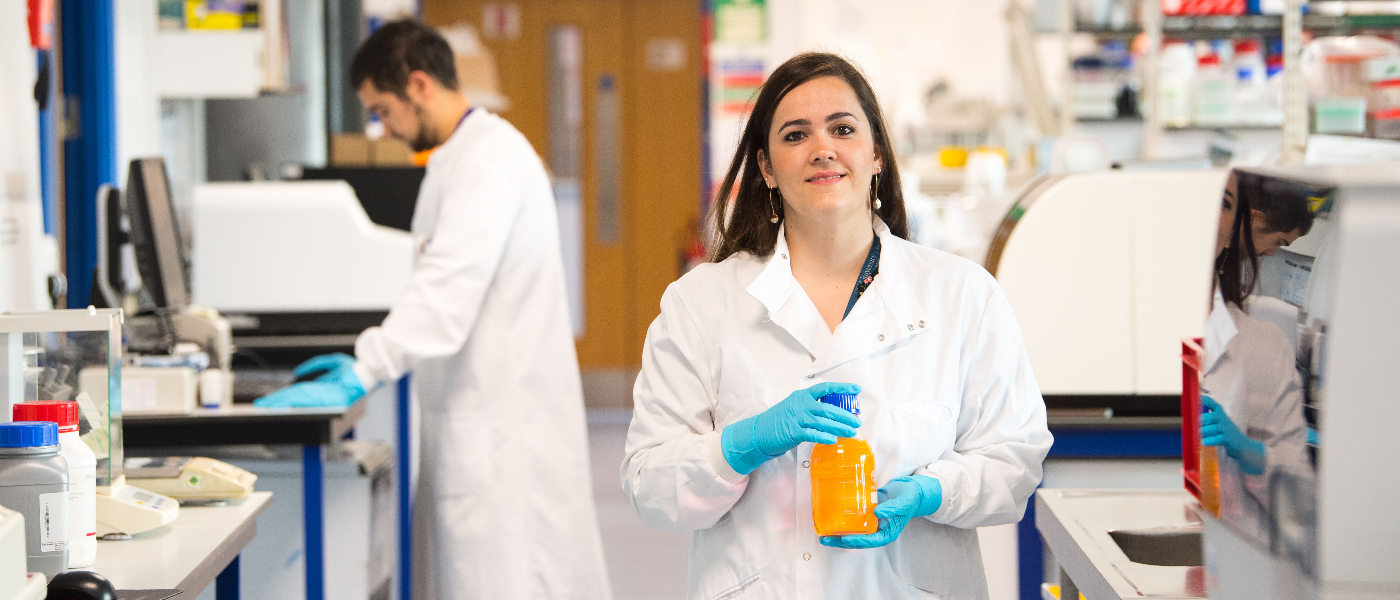Scientists working in today’s labs are constantly innovating.
So it makes sense that the scientific spaces they inhabit are just as dynamic. Because in our opinion, there’s no off-the-shelf approach to laboratory design. Not for the ones that stand the test of time, anyway.
At Evolve, we believe the future of science is forward-thinking and flexible. And with lab design evolving alongside the changing needs of modern scientists, there’s never been a more exciting time to join this industry.
But when things are moving this fast, how on earth are you supposed to keep up?
The shift from the traditional lab
The traditional laboratory, characterised by rows of benches, fixed workstations, and rigid layouts, has served as the cornerstone of scientific research for decades. However, as research has become more complex, collaborative, and data-intensive, the limitations of traditional laboratory design have become apparent.
Laboratories have undergone a remarkable transformation over the years, reflecting the ever-evolving nature of research and the growing demands of modern science. From traditional, utilitarian spaces to adaptable, technology-driven environments, laboratory design has adapted to accommodate new methodologies, collaboration styles, and safety standards.
Let’s explore some of the laboratory design trends we can expect to emerge this year.
More flexible labs
Flexible working has turned the working world on its head – perhaps irreversibly so. And its impact on lab spaces is no different. The global laboratory design market is expected to reach $10.4 billion by 2027, and today’s laboratory design emphasises flexibility and adaptability, catering to the diverse needs of modern scientists. Modular furniture, reconfigurable workspaces, and adaptable infrastructure allow laboratories to seamlessly transition between different research projects and accommodate new technologies. This flexibility fosters innovation and collaboration, enabling scientists to adapt to the dynamic nature of their work.
In research and development (R&D), more and more clinical and controlled environments are now being designed with flexible furniture, e.g. locking casters that allow you to rearrange benches and workstations – as well as vertical stands that provide more economy of space. Not only that, some of these include in-house services such as gas and air that can be delivered via articulated arms fixed onto the ceiling.
This means that when a bench relocates, these essential features move along with it. Cutting-edge technology like this makes it so much easier to reconfigure the space, speeding up scientific workflows in the process. Importantly, it can help design teams make a wide variety of cost savings too. That’s because research can quickly move in new scientific directions, without the need for dedicated bench spaces or any major building renovations.
Flexible working and collaborative spaces also enable teams to innovate more easily. Much like traditional coworking spaces, when lab spaces can be rearranged and opened up for more researchers, they encourage faster and more effective research and development. The beauty is that these researchers can work from inside the lab – or dial in from anywhere.
More cloud-based collaboration
Heightened collaboration in clinical and controlled environments isn’t an entirely new laboratory design trend. In fact, open-plan labs would often have twelve or more benches in one space; all in an attempt to increase collective thinking and creativity.
But more people together doesn’t always lead to increased efficiencies and outputs. And the past few years taught us that a remote model is a viable option for office workers who can be just as productive collaborating from anywhere. That’s why creating hybrid-style environments has become so popular in the design process. But if that’s the case, why shouldn’t they work for laboratories too?
As a matter of fact, they do. Last year, more and more labs were relying on cloud-based technology to facilitate long-distance collaboration, faster drug development and other types of R&D. That’s because it’s quicker, more secure and allows for agile ways of working. Crucially, it can centralise vast amounts of data which has countless benefits for researchers around the world, e.g. allowing multiple scientists to interact, share data and unlock new ways of advancing research – all across multiple time zones.
But this isn’t the only tech that’s transforming the way researchers work. Technology has revolutionised the way scientists conduct research, and laboratory design has evolved to seamlessly integrate these advancements. From automated systems to data analytics tools, laboratories are increasingly equipped with cutting-edge technology to streamline workflows, enhance data collection and analysis, and improve safety protocols.
Smarter labs with automation
As technology accelerates at a rapid rate, we’ll also see more life science organisations create their own “smart labs”. Advances in fields like artificial intelligence (AI) have spurred the invention of a number of useful lab-based tools. These include sample freezers powered by sensors, lab benches that clean themselves and smart safety goggles that display useful information in real-time.
But that’s only the beginning of where things are heading. This year, automation is leading the charge in supplementing – or even – replacing traditional lab equipment and processes. In fact, many innovative labs are swapping their benches with robotic workstations; ones that use miniaturised technology to optimise space.
And this isn’t the only way automation is freeing up real estate. The automatic collection of vast amounts of scientific data means large areas of these environments can be used for other activities. But the data that scientists do interact with are also being interpreted much more efficiently; computational modelling, machine learning and visualisation tools are making these jobs far easier than before. So watch this space, because as AI and automation advance, more innovative and cost-effective tools will become mainstream; all designed to reduce workloads, free up creative thinking and make the idea of joining the scientific space even more appealing.
The good thing is that there’s already an incentive for innovative companies to get involved in science and technology. And their projects don’t even need to be successful to reap the rewards.

Greater sustainable science
It’s no secret that resource-intensive spaces such as labs can leave large carbon footprints. But this fact hasn’t been lost on the scientific community; one that’s well-known for creating innovative solutions to some of the world’s most pressing problems.
With climate concerns growing with rising temperatures, so too are the ways in which today’s labs are battling to reduce their environmental impact. And they can do so right from the offset.
The selection of building materials and furnishings plays a significant role in the overall sustainability of a laboratory. Opting for sustainable materials, such as recycled content materials, low-emitting materials, and sustainably harvested wood products, can reduce the environmental impact associated with material sourcing, production, and disposal.
Sustainable laboratory design extends beyond the physical structure, encompassing operational practices and behavioural changes. Implementing green cleaning protocols, promoting sustainable procurement practices, and fostering a culture of environmental awareness among laboratory personnel can further enhance the sustainability of laboratory operations.
By embracing sustainable laboratory design principles, research institutions can significantly reduce their environmental footprint, mitigate the impact of their operations on the ecosystem, and contribute to a more sustainable future for scientific advancement. As laboratories continue to push the boundaries of knowledge, sustainable design strategies will play an increasingly important role in ensuring that scientific progress aligns with environmental stewardship.
Worryingly, the EU’s heating sector accounts for almost one-third of the EU’s annual carbon footprint. But there are a couple of ways you can incorporate heating into your lab design that’ll make a big difference. Firstly, insulating your building can radically reduce the amount of fuel needed to heat it and lower its carbon emissions. And secondly, integrating renewable energy is a great way to reduce your climate footprint. Solar PV panels are widely becoming the go-to form of renewable tech and we’re now working with a number of clients that are using solar arrays in their laboratory spaces.
Sustainable laboratory design works to minimise the environmental footprint of laboratories, encompassing energy efficiency, water conservation, waste reduction, and sustainable materials selection. Sustainable laboratory design practices can reduce energy consumption by up to 50% and water consumption by up to 30%. Because of this, contemporary designs often include energy-efficient equipment, water conservation measures, and the use of eco-friendly materials. By integrating these principles into the design process, laboratories can significantly reduce their environmental impact while preserving the integrity of scientific research.
However, creating a more sustainable scientific space isn’t just good for the environment; it creates a more enticing place for employees to work too. Using natural furnishings, optimising light and ensuring there’s enough outdoor space are all great ways to boost employee wellbeing. Add to this a commitment to operate more sustainably and your organisation can suddenly seem much more appealing to work for than the competition. This is more important than ever in today’s increasingly competitive landscape around attracting and retaining talent. When there are so many possibilities for science’s bright young stars, make sure your space prioritises their wellbeing and stands head and shoulders above the rest.
Key considerations for laboratory redesign
When embarking on a laboratory redesign, it is crucial to consider the following factors:
-
Research Needs: Clearly define the specific research needs and activities that will take place in the laboratory. This will inform the layout, equipment, and safety features required.
-
Workflow Optimization: The demand for flexible laboratory spaces is expected to grow by 25% by 2025. Laboratory layouts will be optimised for workflow and will minimise unnecessary movement, reducing time spent on non-research tasks.
-
Safety Standards: Adhere to all applicable safety standards and regulations to ensure the well-being of scientists and protect the environment.
-
Sustainability: Implement sustainable practices to reduce the laboratory’s environmental impact.
-
Collaboration and Communication: Facilitate collaboration and communication among scientists by creating designated meeting spaces and fostering an open-plan environment.
How Evolve can help
Redesigning a laboratory is a significant investment, but it can also be a catalyst for scientific innovation and discovery. By incorporating the latest trends and best practices in laboratory design, research institutions can create spaces that empower scientists to reach new heights of discovery, while promoting sustainability and well-being at the same time.
For more information on our laboratory design services, contact the Evolve experts today.
This is who we are
Our programmes and partnerships, innovations and investments, and the positive impact we’re having in our communities
At Evolve, we always put our customers first
We spend time getting to know you, to fully understand the challenges facing your organisation, the trends in your industry and your goals for the future. We use this information to design and implement solutions that are tailored to your specific needs.
When you work with Evolve, you benefit from our stable supplier network, reputable brand partners, an in-house technical services team and reliable delivery.
Evolve is a team of problem-solvers. We know that, in order to succeed, our customers need an end-to-end service which maximises efficiencies and streamlines operations.
With a diverse team made up of scientists, engineers and project managers, we leverage our collective knowledge, agility and scale to deliver efficiency, innovation and assured outcomes.


